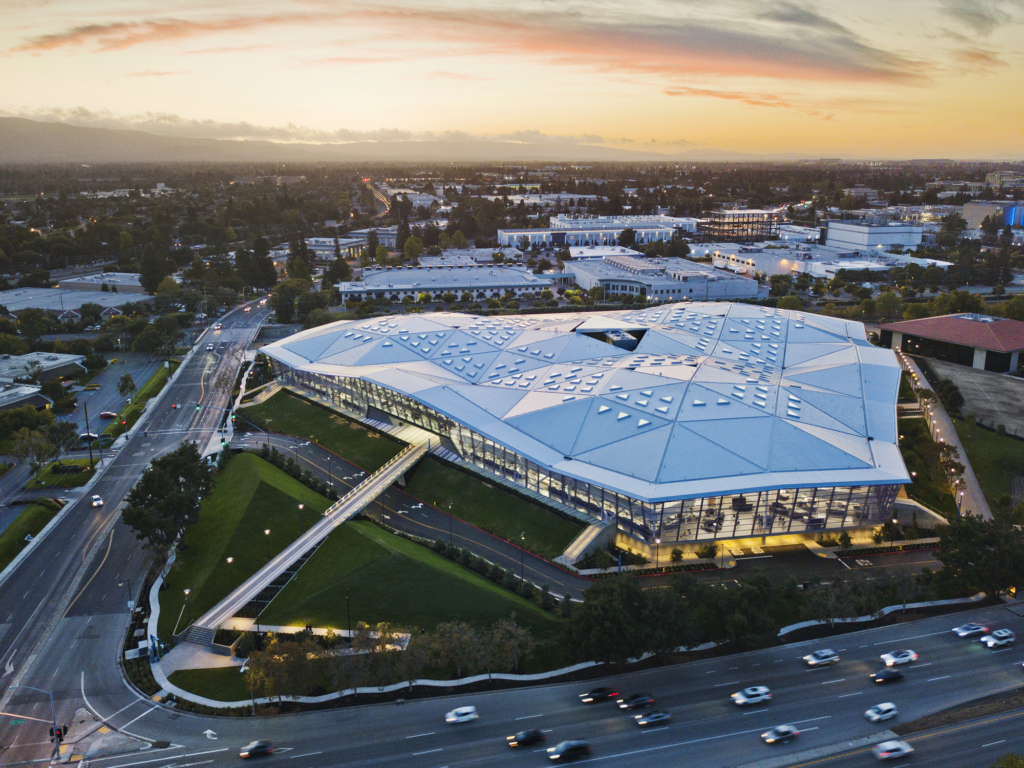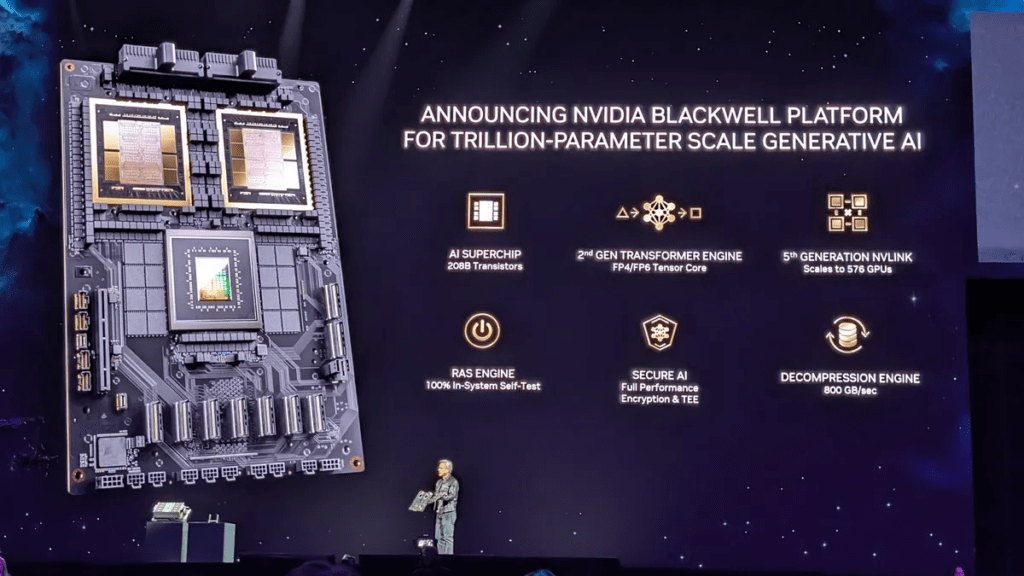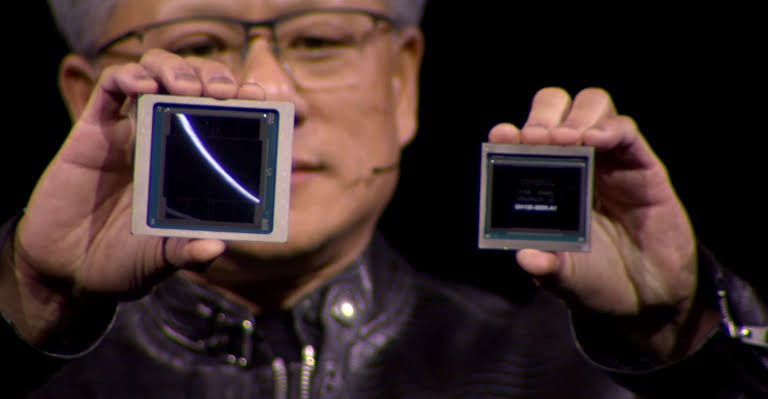NVIDIA is mainly known for making graphics cards for gaming computers , it makes extraordinary softwares and hardwares for AI etc but today it’s more than that. NVIDIA has developed the smartest chip ever made by humankind to date, the Blackwell superchip. The reason behind it being called as the smartest or superchip is the AI-based architecture consisting of 208 billion transistors. Today, NVIDIA has become the most valued company in the world with $3.3 trillion in terms of market capitalisation.

in Nvidia’s 2024 GTC, San Jose, USA
In this article, we’ll give you a quick look at how Nvidia started out and how far it’s come with its groundbreaking inventions. Subsequently, we’ll dive into all the important details about the Blackwell chip.
Table of Contents
History of Nvidia
After the release of the first CGI movie with real character-based ‘Jurassic Park,’ the boom of 3D graphics came into existence, leading Americans to purchase more computers. In 1990, 15% of Americans had computers, but this increased to 35% by 1997, which led to the founding of NVIDIA. It was founded on 5th April 1993 by Jensen Huang, Chris Malachowsky, and Curtis Priem in Santa Clara, California.
At that time, central processing and graphic processing were done by the CPU until the arrival of the Nvidia GeForce 256 GPU. This GPU was revolutionary because it included an integrated Transform and Lighting (T&L) engine, significantly improving 3D rendering capabilities. NVIDIA’s invention of the GPU marked a major milestone in the graphics industry and has since been associated with the term GPU.


In 2006, the company introduced CUDA (Compute Unified Device Architecture), a parallel computing platform and programming model that allowed developers to leverage the power of GPUs for general-purpose computing. This was a pivotal move that expanded NVIDIA’s influence beyond graphics into high-performance computing (HPC) and AI. Before the arrival of CUDA, GPUs were based on serial computing, but CUDA introduced parallel computing, which revolutionised the GPU.
Since 2010, NVIDIA has taken many progressive steps, such as the Kepler architecture in 2012 and the Maxwell architecture. NVIDIA GPUs were mainly used for gaming until the introduction of RTX in 2018, which began to be used by graphic designers, gamers, developers, and others.
Expansion into Data Centres

NVIDIA expanded into data centers to meet the rising demand for AI and computing power. They developed specialized Tesla GPUs, starting with the K80 and evolving to the A100, to handle intensive AI and data analytics tasks. NVIDIA acquired Mellanox Technologies in 2019, enhancing their networking capabilities and optimizing data center performance. They also partnered with major cloud providers such as AWS, Microsoft Azure, and Google Cloud to integrate their GPUs into cloud data centres.
The launch of the Ampere architecture, featuring the powerful A100 GPU, provided significant performance improvements for various workloads. Additionally, NVIDIA introduced comprehensive AI platforms like NVIDIA AI Enterprise to integrate AI tools into data center operations, solidifying their position as a leader in data center solutions.
Today, NVIDIA’s revenue is roughly balanced between gaming (40-45%) and data centres (40-45%). While gaming remains vital, the rapid growth in data centre revenue reflects a strategic shift towards AI and enterprise solutions. Since its inception, NVIDIA has been involved in designing chips but not manufacturing them because it’s specialised by Taiwan Semiconductor Manufacturing Company (TSMC). NVIDIA has outsourced TSMC since the beginning, allowing Nvidia to focus only on designing.
Blackwell Chip
On 18th March, at Nvidia’s 2024 GTC (Graphics Technology Conference) in San Jose, California, Jensen Huang introduced the Blackwell Architecture. It is a a groundbreaking GPU microarchitecture, named in honour of the esteemed mathematician and statistician David Harold Blackwell. The Blackwell chip refers to a specific hardware component, while “Blackwell architecture” refers to the broader design and structure of a computing system or framework.

Designed with the aim of revolutionising the capabilities of artificial intelligence (AI), Jensen Huang proposed that this GPUs will be used to train one of the biggest models of AI with trillion parameters in size. The most recent model from OpenAI will have 1.8 trillion parameters, ten times more than ChatGPT. The Blackwell GPU architecture will help in transforming various important domains in the field of computing like engineering simulation, quantum computing, data processing, generative AI etc.
Here’s what you need to know about the Blackwell chip:
- Unprecedented Power: Boasting an impressive 208 billion transistors, it stands as the most powerful single-chip GPU to date.
- Enhanced Efficiency: It is projected to drive significant improvements in AI inference operating costs and energy consumption, potentially reducing them by up to 25 times compared to its predecessor, the H100 (Hopper).
- Innovative Technologies: The Blackwell platform introduces six transformative technologies for accelerated computing, including a second-generation Transformer Engine and fifth-generation NVLink.
- Superchip Integration: As part of the GB200 “superchip,” this is combined with two B200 chips and a Grace CPU, further enhancing its performance capabilities.
- Industry Adoption: Major industry players such as Amazon Web Services, Google, Meta, Oracle,OpenAI and Microsoft are keen to adopt this platform, recognising its potential to drive significant advancements in AI and computing.


Nvidia CEO Jensen Huang stated in an interview that a Blackwell GPU will cost between $30,000 and $40,000. He added that Nvidia invested $10 billion in its entire creation.
Conclusion
From the start, Jensen Huang knew that the upcoming era would be the era of AI and advanced graphics, which led him to invest in AI. In the future, NVIDIA may achieve more breakthroughs. It is currently a prominent player in the ongoing Chip War between USA and China. It’s interesting to see the future of AI unfold.
